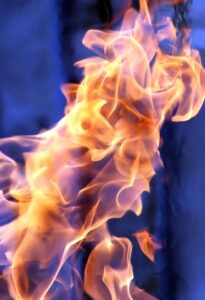What is the need or importance of flash point? In many engineering applications, fuels are used for getting thermal energy by combustion of fuel. For example, in an oil-fired furnace, oil is ignited and heat is used for heating the metals at high temperatures to alter their properties. Fuel selection is also one of the most important parts.
One needs to use and select fuel based on its properties like calorific value, density, viscosity, specific heat, and flash point, and fire point. Now, we will understand first the meaning of a flashpoint and a fire point, What is the difference between a flash point and a fire point, and later its importance.

Table of Contents
What is a flash point and fire point?
It is the minimum temperature at which a fuel or lubricant gives off sufficient vapor (when heated) to ignite for a moment giving a momentarily flash. This is the lowest temperature when sufficient vapors start coming from fuel and get mixed with air to generate an air-plus-vapor mixture.
This mixture can get ignited when the ignition source is given to it. When it reaches the minimum temperature called the flash point, fuel gives off a momentarily flash. If the heating continues, the vaporization rate increases and the fuel reaches in fire point range again if the fuel is given an ignition source, it starts burning continuously. This temperature is called the fire point.
Conditions that affect flash point and fire point
The flash point requires an ignition source whereas ‘auto-ignition temperature’ does not require a source of heat. This is the difference between flash point and auto-ignition temperature. While ‘Flash Point’ depends on the vapor pressure of that lubricant/fuel and it increases as the temperature of the fuel/lubricant increases. When vapor pressure increases, molecules find it hard to leave the liquid surfaces and require more energy to escape in the form of vaporization.
A fire point is the temperature at which fuel is heated to give off sufficient vapors so it can continue to burn for more than 5 seconds is called a ‘Fire Point’. Normally ‘Fire Point’ is more than ‘Flash Point’ by 10-20 °C. ‘Flash Point’ and ‘Fire point’ are determined to measure fire resistance and its volatility.
Measurement of flash point and fire point
Flashpoint and fire points can be determined experimentally by the use of Cleveland’s open apparatus or by Abel’s closed cup apparatus. The accuracy of the value of the flash point and fire point depends on which apparatus is used.
Importance of flash point and fire point:
By knowing the value of the temperature at which fuel catches fire, one can handle as well as store the fuel and transport it safely. This is why knowing petrol and diesel’s flash point and fire point, every petrol pump wants petrol and diesel to be stored underground. Thus, flashpoints and fire points help in determining the nature of fuel’s Flammability.
A lower value of flash point means fuel is highly flammable. A substance having a low flash point generates flash too early during heating and is called highly flammable. Thus, this kind of fuel requires special care during storage, handling, and transportation. Every industry that handles or uses fuel or volatile substances has to follow regulatory compliance for safety, storage, and transportation based on the values of fuel’s flash point and fire point.
When one is selecting a fuel, these flash point and fire point values help them to understand its flammability during use and storage. One can even be aware of critical temperatures where one cannot use fuel to get away from its fire point temperature. Violating fire points can be riskier for human beings and the industry itself too.


why diesel has higher flash point than petrol
why diesel has higher flash point than petrol and also calorific value
Hello, my name is Rushikesh.from SE mech.
If we got flash point of a fuel,then why should we go for fire point ? What is the advantage of fire point over flash point ?
[…] as calorific value. Before we use any fuel, we must have information about the calorific value, flash point, fire point, density, specific heat, pour point, etc. Any fuel that is to be used in any […]